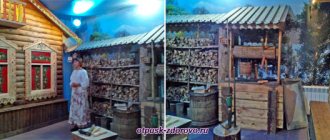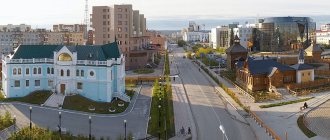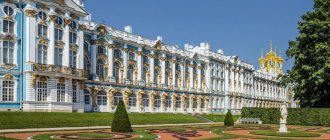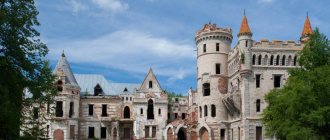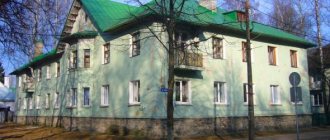Population
City population dynamics:
| Year | Population, people | Source |
| 1859 | 2 416 | |
| 1890 | 3 406 | ESBE |
| 1926 | 5 828 | 1926 Census |
| 1989 | 14 191 | 1989 Census |
| 1979 | 12 400 | 1979 Census |
| 1897 | 3 182 | 1897 Census |
| 1959 | 7 490 | 1959 Census |
| 2002 | 13 328 | 2002 Census |
| 2010 | 12 035 | Rosstat estimate |
| 1970 | 10 535 | 1970 Census |
origin of name
The city is named for its location on the Sudogda River. In turn, the hydronym, according to the most common version, is of Finno-Ugric origin[3]. According to it, the hydronym comes from the ancient Finno-Ugric “Sutkeda/Sudgeda” (“Winding”), which actually reflects the topography of the river bed. The name of another river in the Sudogodsky region, Soima (Suoima), comes from the Finno-Ugric “Suoyama” (“Defender”)[4].
According to another version, it comes from the Tatar su
- water and
dogd
- around (“there is water all around”, “big water”; accordingly, the name of the Soima River is explained as “small water”)[5].
Neighborhood
- In the village of Muromtsevo (3 km southeast of Sudogda) there is a palace and park ensemble (1884) of the estate of Count V. S. Khrapovitsky. After the revolution, the estate was used as a real school, was subsequently abandoned, survived a fire and until recently was in deplorable condition. Currently, work is underway to restore cultural heritage and monuments. Some buildings are used by the Muromtsevo Forestry Technical School for educational premises. Of particular interest is the park, where the count collected trees from different countries, as well as the so-called “dog hill”, where Khrapovitsky’s pack of hunting dogs, which he ordered to be killed after 1917, before immigrating abroad, are buried.
Old fellow
It’s an amazing thing, after all: either our city is so unlucky, or the threads of its history are really too tangled, sometimes going back to the most ancient times - but wherever you throw it, no matter what article or book you pick up (and there are quite a few of them anyway), - you will definitely find a wide variety of blunders and inaccuracies, which, among other things, are also very tenacious... “False” quotes are spreading right and left, like hot cakes at the market - and soon, very soon you won’t even find the answers, and you won’t know where some of the bizarre statements come from... Like the fact that the owner of the estate in Muromtsevo, Vladimir Semyonovich Khrapovitsky, allegedly bore the title of count... But he never was! However, since childhood we have been repeating one after another: “Count Khrapovitsky” and “Count Khrapovitsky”... So we will devote not one, but a whole series of articles on our website.
Let's open one heavy, thick book... After rustling the pages, we find what we were looking for.
“ Sudogda is a city in the Vladimir region. Flax spinning factory, fiberglass plant. Founded in 1552."
In fact, such information about our town is given in one of the most popular reference publications of Soviet times - in the “Soviet Encyclopedic Dictionary” (the one we are leafing through is published in 1979, but I am more than sure that in other years the information was reprinted without changes). A little, right? Nevertheless, this is the “dry residue” that the compilers considered the most important... And worthy of attention on an all-Union, so to speak, scale.
But what ’s depressing is not even the sheer brevity of this information (needless to say, it’s not that great...), but two other facts at once - and I’ll say right away that we will try to eliminate both of these reasons for grief today.
The first is that the overwhelming majority of Sudogod residents themselves would not be able to add anything to this, speaking about the ancient milestones of our local history.
Well , the second one is ambiguity in the text of the dictionary entry itself... That’s where we’ll start.
“Founded in 1552” ... What does “founded” mean? In fact, the case when a certain historical figure comes to a hitherto uninhabited place and solemnly exclaims: “Here a city will be founded!..” is such a rare thing in Russian history that in relation to small towns that have existed for many centuries, this is not even worth talking about - It's not really worth it. Yes, we won’t - because Sudogda did not have any “bookmark”, as well as a foundation, in the traditional understanding of these words, and could not have had one. The year 1552 is truly memorable for her, and the compilers of the publication were not mistaken in this... “Foundation” is usually called the date of the first mention of a settlement in written sources - although it is clear, of course, that they are talking about already existing settlements, and often - existing for a very long time. So, we are talking here, in fact, about completely different events that have nothing even close to do with the “founding” of the city. Which ones exactly? And is the date mentioned in the dictionary correct? This is what we will try to find out today.
The banks of the Sudogda River were inhabited by people several thousand years ago
...But people have lived here for a long time, and, perhaps, it is difficult to find another land in the Vladimir region, the population of which, both in different centuries and at the same time, would be just as colorful and heterogeneous...
Archaeological map of the Sudogodsky region, published by the Russian Academy of Sciences in 1995 as part of the collection “Archaeological Map of Russia. Vladimir region" edited by Yu. A. Krasnov
If we are going to start digging (both figuratively and literally) from the most ancient eras, then the conversation should begin with archaeological excavations on the territory of the Sudogodsky district... Which practically did not exist. That is, they were, of course, but compared to how much the neighboring Vladimir and Murom territories have been studied, Sudogodskaya land is still the same “blank sheet”. The archaeological map of the Vladimir region, published by the Russian Academy of Sciences in 1995, shows only a few points along the Sudogda River in the Sudogodsky district, the oldest finds of which date back to the Mesolithic and Neolithic eras. In other words, these places were inhabited at least seven thousand years ago... or even ten. The “catch” of archaeologists, testifying to the life of our fellow countrymen in those distant times, is not rich: stone tools similar to knives, flint flakes, a grindstone, burnt and split stones - that’s practically all that was found on the banks of Sudogda and Klyazma. The bones of animals and fish have also been preserved, indicating that these people lived by hunting and fishing.
The town of Osanovka near the village of Lavrovo, Sudogodsky district. Several ancient human sites were discovered here, including the oldest ones dating back to the Mesolithic era.
Stone knife and arrowhead found in Sudogodsky district
In later layers there are more finds, but they are almost entirely fragments of ceramics, which also attracted very little interest from researchers.
However, everything is not so hopeless with the prospects for excavations, if we consider such finds not from the point of view of their uniqueness and inimitability, but precisely as evidence of the life of our region in distant centuries. But the same burial mounds of the pre-Mongol era, of which there are quite a lot here, are, alas, much more of interest to “black diggers” than to professional archaeologists. So it turns out that the funds of the region’s museums are replenished not with objects found during excavations, but with artifacts accidentally discovered, sometimes just lying around under the feet of local residents - for example, at a popular bathing place, almost within the city limits, pit-comb ceramics were found, in in the Posadka microdistrict - a stone arrowhead, near the village named after Vorovsky - several stone tools at once... None of these “deposits” are on the Archaeological Map of the Russian Academy of Sciences.
A fragment of pit-comb ceramics found in the bed of the Sudogda River. Presumably - about 3 thousand years BC.
Meanwhile , the very geographical location of Sudogda (the only river in the area plus a busy road passing through these places since ancient times) gave rise to that diversity of events and people, which in a historical context is all the more curious for us. The original inhabitants of this land were Finno-Ugric tribes who spoke their own languages (different, albeit close) and each had their own special culture. And just at the site of the current Sudogodsky district there was a “junction” of three territories at once: the Merya, Murom and Meshchera tribes lived here. The most interesting thing in all of this, perhaps, is that it was precisely on the periphery, in remote places, far from the main settlements after the arrival of the Slavs, that untouched “islands” of the Finno-Ugric culture traditional for these places could survive for the longest time. Therefore, we will not talk about the times of existence of these tribes indicated in any reference book - but rather, we will talk about what does not fit into the “textbook” dates... But it is not a proven fact in the full sense of the word. Perhaps - for now...
It remains to be seen which source was meant, but there is a story among local historians that in one of the revision tales (a document drawn up after a kind of “population census” for the purpose of imposing a poll tax) of the 18th (!) century, Sudogda is listed like a Finnish settlement. Moreover, people still live here who consider the people of the Muroma tribe to be their ancestors. All this may sound quite strange (and, I repeat once again, before being elevated to the rank of a historical fact, it requires a comprehensive and thorough verification), however, as they say, there is no smoke without fire...
But if we’re talking about things that you can not only think about, but also hold in your hands, please, there are those too. In the Sudogodsky Museum of Local Lore. I was surprised when I saw how similar the samples of wicker baskets made from pine roots (a very exotic craft in itself, you must admit) exhibited in Sudogda were to the same things from local museums dedicated to the culture and life of the Finno-Ugric tribes living and to this day on the territory of the Leningrad region.
Baskets woven from pine roots. From the funds of the Sudogodsky Museum of Local Lore
And the word “Sudogda” itself... Perhaps none of the other local history issues of “local significance” gave rise to as many fantasies as this one. Whatever they connected him with! And with the Slavic word “sudok”, and with the Tatar “su” (really existing - “water”) and some Tatar hypothetical “dogda” (supposedly - “around, around”), which in fact is not found in this language , as well as those similar to it in sound and meaning... And of course, even without being a linguist, it is not difficult to notice that the “Slavic” and even more so the “Tatar” versions are too “young” to seem at least somewhat truthful. For Sudogda is also a river, and it is natural that the city is named after it, and not vice versa. And it is precisely hydronyms (names of bodies of water) that always preserve the most ancient traces of local languages - and there can be no two opinions that the word “Sudogda” is, after all, of Finnish origin, and not of any other.
As a matter of fact, this was already proven several years ago, quite convincingly, by the Moscow linguist Vitaly Chernyavsky, who carried out work on deciphering the hydronyms of the Sudogodsky region on the basis of modern Finnish and related languages, including ancient ones. He translated the word “Sudogda” as “winding”, and this name seems very apt - you just have to look at the sharp bends of the bed of our river on the map...
The tortuosity of Sudogda does not raise doubts about itself...
This is where we come to the question with which we began this article. Namely, what dates associated with the history of our town can we consider the earliest? Naturally, we learn them from written sources - such as chronicles and other written documents of distant centuries. There are such, and there are even several of them - the oldest, the most significant. Sudogda is mentioned in them - and not even once, but several times - in the 16th century. Many of us have at least heard about this once... But I would venture to suggest that only a few will be able to immediately remember what exactly these documents are. And no one can boast of having seen them “live”...
Meanwhile , you wouldn’t have to go far to do this. Thanks to the works of a great friend of the Museum of Local Lore (and simply a wonderful and caring person), Muscovite Ilya Kartashev, the museum now has not only copies of two of those same texts, but also all the information that can be connected with them. In this article, the “fateful” pages of ancient documents for Sudogda are reproduced for the first time, and our fellow countrymen can now finally see them with their own eyes.
And so, the earliest mention of Sudogda known so far... Finding it turned out to be a difficult task, but an indication of its existence was contained in another, equally venerable source, which, if not for the merciless time, could itself become the “starting point” of the Sudogda history - in the order column of the noble family of the Karamyshevs.
What kind of document is this “order column”? The genealogies of people in the government service used to be kept very carefully, this was done in the Rank Order, where year after year, when it was necessary to add new information to an existing document, new ones were glued to the bottom of the old sheets, and the result was a long, very long scroll , - this is what got the apt name “column”. This is where, by the way, the expression “pillar noblewoman” (or nobleman), known to all of us since childhood from Pushkin’s “Tale of the Fisherman and the Fish,” came from, indicating the antiquity of the noble family.
So , in the Karamyshev scroll - at its very beginning - the following appears: “... and a stipend was given to Vasily Vasilyevich. certificate in feeding from V. book Iv. Vascha on Rzhev... ten-ninth year... Vasilyevich has four sons... Alexander, Timofey... Dana Zhalov. gram[ota] ... milk from v. book You. Ivanovich to Listvin, and to Sudogda.”
Therefore , the object that interests us is precisely the letter of Grand Duke Vasily III, according to which the boyar Karamyshev was granted “to feed” Sudogd. Unfortunately, you yourself can see how little can sometimes be understood from the cherished lines that are so important to us, even if they fell into our hands... The letter itself has not survived to this day. But there have been enthusiastic historians at all times, and thanks to the works of researcher Alexander Yushkov, who studied the Karamyshev column more than a hundred years ago and deciphered the copy of the letter contained there, we can today say with complete confidence that we know what was written in it. Here we present a page from the collection published by him:
Judging by the abundance of omissions, already a century ago the state of the document left much to be desired. The main problem is precisely that the dating of the entry into the text column of the charter itself has been lost, and only the date of confirmation of the charter, set by the clerk who made the following entry, has been preserved.
The word “confirmation” in this case means “extension”. As we see from the text, Sudogda was granted to the boyar “for feeding,” that is, not forever, but temporarily - usually this period was one year, much less often - one and a half. That is why Alexander Yushkov put a question mark after he almost certainly correctly established the date of writing the letter itself: 1529 (?)... And it is precisely because of this smallness, because of this very sign, that the date is interpreted so differently in modern sources “foundations” of Sudogda: “1529” - for those who considered this probability sufficient; “1552” is for those who are accustomed to using only 100% accurate and verified data.
However, to complete the picture, we must look at the second source, according to which the compilers of the Soviet Encyclopedic Dictionary designated our main date. And again, what appears before us is not the original document, but its copy... But this time it is a reprint edition, that is, reproducing the document in its original form. In addition, we were incredibly lucky: the text of the manuscript was perfectly preserved.
Before you is the creation of an unknown chronicler, the title is very long: “The legend of the conception of the Kingdom of Kazan, and of the victories of the Grand Dukes of Moscow, gloriously accomplished with the Kings of Kazan (...) the Pious Sovereign Tsar and Grand Duke John Vasilyevich, Autocrat of All Russia.” We are talking here, as many have already guessed, about Ivan the Terrible, and it is with his name that another mention of Sudogda is associated.
Since reading Old Church Slavonic texts is a task that not everyone is up to, we will “translate” this text and, in addition, we ourselves will tell a little about the events described in it.
The episode to which the page we are interested in took place occurred shortly after the capture of Kazan by the young king (he was only 22 years old at the time). From the conquered fortress, he hastened to set off on the return journey: his dearly beloved wife, Anastasia Romanovna, was waiting for the sovereign, who was about to be delivered of her childbirth. Before this, the couple had already given birth to two girls, and both died, and therefore one can imagine with what trepidation and hope the young king awaited the birth of the long-awaited heir... One day, while walking home with his retinue, he met a messenger who brought good news. The chronicler tells us about this:
“In the summer of 7061, the month of October on the 11th day, in memory of the holy Apostle Philip on Tuesday, the Orthodox Tsar went to his father’s throne in health with all the people, bringing a bright and radiant victory... And he went from his homeland from Kazan, and spent the night on the sand on the Volga opposite Gostin Island, in the morning you will go to the new city of Sviyazhsk, and there you will spend one day, and you will go from Sviyazhsk on Thursday [Thursday] ... and you will come to Nizhny Novy Grad [Nizhny Novgorod], and you will remain here for two days, and you will go to struzeh [strugakh] to Balakhna along the Volga River, and from Balakhna, mounted on a horse, the noble prince went to the yam [post station], called Sudogda .
And then you will meet his messenger, the boyar Vasily Yuryevich little Trakhaniot, and he announces to the Sovereign Tsar a calico greeting: ... Your wife, the Empress Tsarina Grand Duchess Anastasia Romanovna, is well, and you, the Great Sovereign Tsar, have given birth to a son, Tsarevich, named Dimitri.
And then unspeakable joy came to the Orthodox Tsar, as if his image was blooming, and his heart rejoiced with joy, constantly glorifying God.”
These are the lines thanks to which Sudogda can identify the earliest (reliably known to date) milestones of its history. Now you are not familiar with them “in absentia”, from the meager references in encyclopedias, but you have looked at them with your own eyes. Curious, isn't it?
Let us remember that to recalculate the years “from the creation of the world” to the modern style, 5508 years should be subtracted from the indicated date (or 5509 if the event took place from September to December). Thus, we get the reliably known year 1552 .
No less interesting are other, later pages of the history of our town, outlined by a variety of people, but one way or another leading us back along the path of Time. We will walk along it more than once to see how the pictures of Sudogodsky’s Past come to life, preserved in someone’s memory - and once entrusted to paper pages, now yellowed...
City layout and attractions
The old part of Sudogda, located on the left bank of the river, has preserved the historically established rectangular grid of streets. On the central street named after Lenin (formerly Ekaterininskaya), buildings of the 19th - early 20th centuries are of interest, including the house of the founder of the Sudogod glass factory Evgraf Golubev and the wooden house of his mother, the buildings of the city fire station and the real school (now school No. 1) , the mayor's house with baroque motifs, the Alexander Nevsky Temple and Catherine's Cathedral. On Krasnaya Street (formerly Dvoryanskaya), a complex of a city estate from the late 18th - early 19th centuries (now a private house) and a former parish school (built in 1903, now a post office) have been preserved almost unchanged. The construction of other streets of the center and the adjacent microdistricts Khoryshevo and Posadka is low-rise, mostly wooden.
On the right bank of the river there are new microdistricts Poyma, Khimik, Stroiteley, Novaya Fabrika, which appeared thanks to the development of the city's largest enterprises - and a textile factory.
Culture, education, sports
In the city there are 2 secondary schools, a primary general education school and an evening (shift) school, an extracurricular activity center, and a children's hockey club “Sudogodets”.
There are two churches, a Sunday school, and a district cultural center. In 2007, a local history museum was opened. The regional socio-political newspaper “Sudogda and Sudogodtsy” is published (founded on April 25, 1931, previously published under the names “Udarnik” and “Leninets”).
A major event in the life of Sudogod residents is the All-Russian tournament of young hockey players in memory of Alexander Ragulin, held annually during the winter holidays (first organized by the Olympic champion himself in 2002).
In 2011, the Sudogda Cross Club organization was created and official motorsport competitions are held.
Notable residents
- Jerome (Chernov) (1878-1957) - Archbishop of Detroit and Flint (ROCOR), a native of Sudogda.
- Kirill Meretskov in 1915-1917 worked at a rosin-turpentine plant in the village of Peredel, Sudogda district, was one of the organizers of Soviet power in Sudogda, in 1917 he was the secretary of the Sudogda district committee of the RSDLP (b) and the chief of staff of the city detachment of the Red Guard.
- Alexey Byakov (1912-1941) - Hero of the Soviet Union.
- Vladlen Sirotkin (1933-2005) - historian, Doctor of Historical Sciences[26].
- Ivan Oshmarin (1920-1943) - Hero of the Soviet Union, was born in the village of Khoryshevo (now part of Sudogda).
- Ekaterina Gradova (born 1946) is a Soviet actress who often comes to Sudogda and lives here for a long time.



